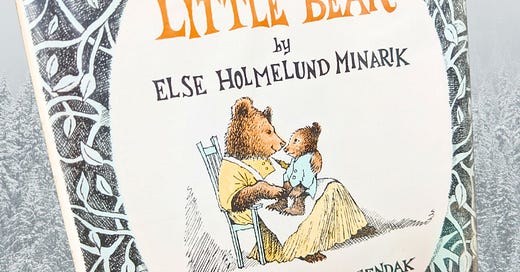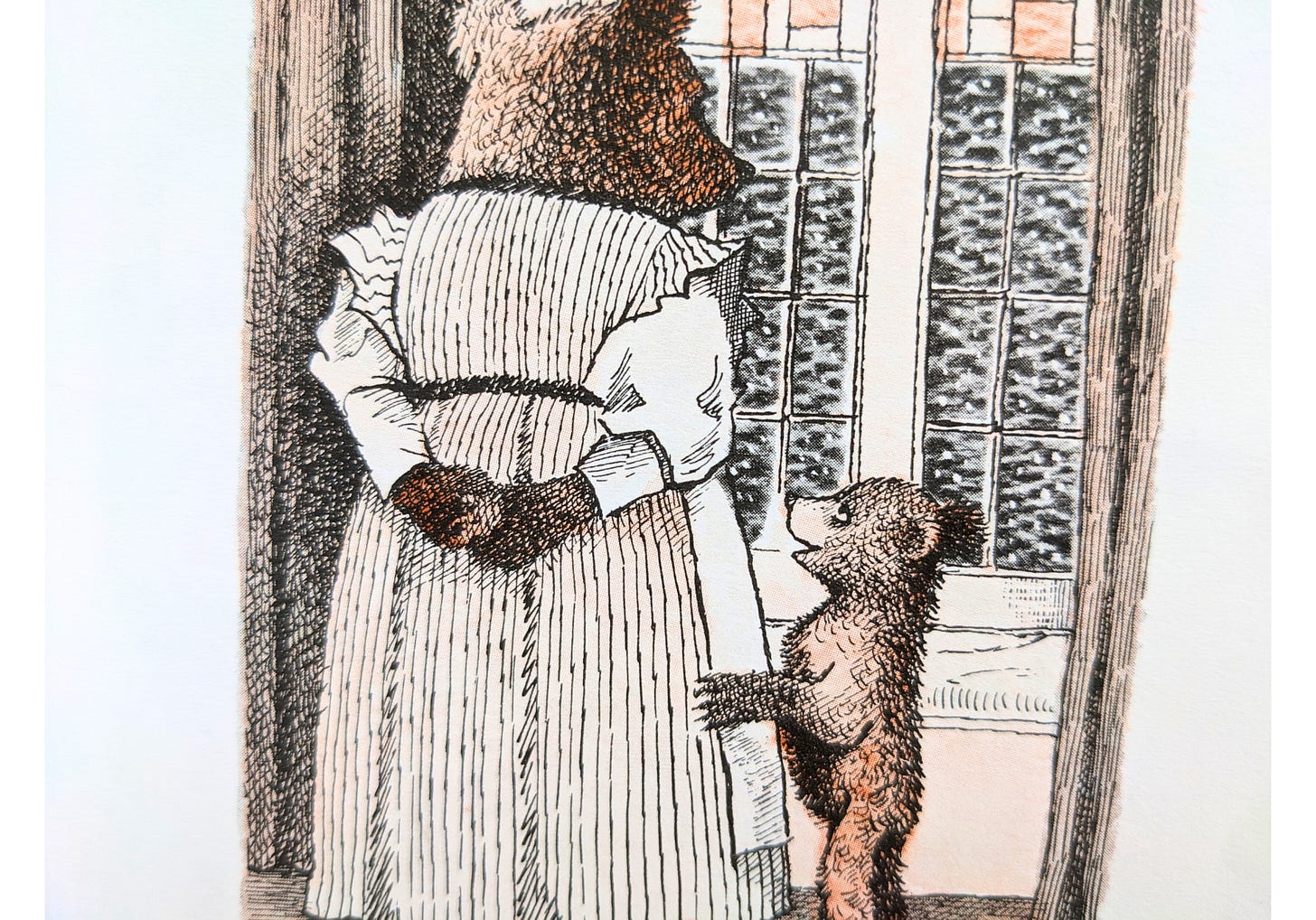I loved Little Bear as a child, and again as a mom, reading it to my children. The stories of a little bear and his mother, so simple and warm, made me feel as though all was right with the world. No complicated plots, no conflicted characters. My shoulders release even just thinking about the book.
Written by Else Holmelund Minarik and illustrated by Maurice Sendak in 1957, it inspired a book series featuring the main character, Little Bear, and later, a television cartoon series in the 90s that I can’t vouch for because we ditched our tv right about then.
The other stories in Little Bear have their own beautiful lessons about friendship, mothering, and imagination. If you have small children, grandchildren, nieces or nephews, read the whole book to them.
But it’s the first story, called WHAT WILL LITTLE BEAR WEAR? that came to me recently, while reading
’s latest post in which she offers her thoughts about a book called Big Mother: The Technological Body of Evil, by Jasun Horsley.I’ve not read Horsely’s book, but Tereza’s quote from it struck me:
“the primary driving force of human civilization is the desire to create through technology a replica of the mother’s body—and then disappear into it.”
Quite an image, yes?
So why did the character of Little Bear, of all things, arrive in my mind at that particular moment? How could that cuddly bear pertain? I’ll tell you.
Because as cute and uncomplicated as he is, he also unwittingly embodies the irony of attempting to build an external path to safety and security.
Kind of a lot for a little bear, but sometimes big lessons come in the smallest packages.
Little Bear looks out the window at the snow and says, “Mother Bear, I am cold. See the snow. I want something to put on.”
I want to point out here that Little Bear is not actually cold; he’s anticipating feeling cold just by seeing the snow pile up outside. This is no doubt apparent to big, matronly Mother Bear, but she humors him by making him a hat, which he puts on and heads outside, saying “Hurray! Now I will not be cold.”
Soon he returns, claiming he’s cold, so she makes him a coat. “Hurray!” he says again, “Now I will not be cold.”
He goes out but comes in again, complaining yet once more of the cold, and his patient mother makes him snowpants. (She’s got some mad sewing skills, btw.) Out he goes, Hurray!-ing, only to return yet again, still cold.
This time when he asks for something to put on, she provides the perfect response:
“My little bear,” said Mother Bear, “you have a hat, you have a coat, you have snowpants. Do you want a fur coat, too?”
Of course he does. So she collects the hat, the coat, and the snowpants from him, saying, “See, there is the fur coat.”
Once again, he cheers, “Hurray!” and states, “Here is my fur coat. Now I will not be cold.”
The next page displays an illustration of Little Bear playing happily in the snow, with his mother standing behind him, a knowing smile on her furry face, followed by the last words of the story:
And he was not cold.
What do you think of that?
Here’s what I think of that.
I think this fable is a profound revelation of the human experience, imbued with deep spiritual truth.
Like Little Bear, we see the cold world around us from the warm comfort of our home, and it scares us. It’s forbidding out there, and there is much to fear: pain, loss, injustice, evil acts, and betrayal, not to mention death.
So we turn to Mother Bear, or That Which Created Us. Call it whatever you like, but this presence, this force, is the embodiment of love. We turn to her for the means to protect us — which we equate, because we are physical beings like Little Bear, with items. “I want something to put on.”
A hat, a coat, snowpants: these garments she willingly gives, knowing all the while that they are just superficial totems that lend us a temporary sense of safety. We accept them eagerly, thinking they will be the answer to our fears.
These items can look like lots of different things because they are, in essence, technology — from the earliest Proto-Indo-European root of that word, teks, meaning “to weave,” or “to fabricate.” Anything real that is constructed, from a hammer to a Hummer, is, by that definition, technology.
But there are other fabricated things, too, that are intangible. Yes, human beings have produced all the TJMaxx crap we think improves our lives, but we’ve also made huge institutions, organizations, and belief systems we think are shielding us from harm. All of that is technology, too.
There has never been a time in the history of the world — as far as we know — when humanity has had more technology, tangible and intangible, than we have right now. It is covering us from head to toe, and we think we need every stitch of it.
I’m not arguing that certain technologies aren’t beneficial. Heck, even Mother Bear wears a voluminous dress, and an apron in the kitchen. What I’m saying is that over and over, our tendency is to turn outside ourselves to seek safety.
We have, as Horsely says, “the desire to create through technology a replica of the mother’s body—and then disappear into it.” It’s technology as escapism, as a return to the womb. Take care of me! we say to institutions we’ve built. Protect me! we say to hierarchies. Entertain me! Navigate for me! Remember for me! we say to screens.
Little Bear keeps returning to Mother Bear, asking for more and more technology, but he doesn’t actually need it. He was created with everything he needs, to face whatever Nature throws at him, including a snowstorm. We were created that way, too, because we are as much a part of Nature as Little Bear.
He came into this world naked but equipped with fur, just as we came into this world naked and equipped with… well, what did we arrive with that gives us the courage to overcome fear?
Love.
As usual, that’s the answer. Because it is That Which Created Us.
We, coming from Mother Bear, are the embodiment of love. We just forget, over and over, because we live more and more in our heads and not our hearts.
We forget, because the system is set up to induce group-amnesia-think, because when we’re afraid to meet the cold outside, we stay sheltered — figuratively and literally — in a state of weakness and disempowerment, a state highly conducive to control.
We forget, because we prioritize physical and emotional safety over the wellbeing of our souls, and lots of people capitalize handsomely on that, selling us things, claiming that THIS IS THE ONE THING we REALLY NEED to STAY SAFE!
And we forget because that’s part of the dance of being human, the hide-and-seek our souls play with the universe that makes the whole game of life so compelling.
And herein lies the paradox.
Remember, Mother Bear knows from the start that Little Bear doesn’t need outdoor snow gear. Standing at the window, she could say, “Little Bear, you are a bear. You have a fur coat. Go outside and play, you adorable ding-a-ling.” But she doesn’t.
She goes to the trouble of making all this stuff for him. Why?
Because in her infinite wisdom, she wants him to learn on his own that Nature has already provided everything he needs. He can’t be any warmer with a hat, jacket, and snowpants on; in fact, who knows? Maybe all that stuff doesn’t actually work on a bear.
But if she just told him that, would he believe her? Or does he have to experience it for himself?
Mother Bear, That Which Created Us, is both the beneficence of Nature, and the cruelty of Nature. She creates us out of love, providing us from birth what we need: the love that conquers all fear.
Then, when we’ve forgotten that immense power of love we already possess, she co-creates with us, giving us what we ask for (technology, please!), knowing full well it can’t fulfill what we think it can.
Which leads me to where we are in our evolution right now.
I think we’re at the point in the fable where Mother Bear, having played along with our requests, is poised to take it all back, all of the “stuff” we’ve put on, the enterprises that are unnecessary at best and harmful at worst. I think what we’ve relied on — the external pacifiers and safety blankets — are going away.
We’re at the point where Mother Bear takes the hat, the coat, and the snowpants away and pushes us out into the snow… because she loves us, because she knows what we really need.
Her final act of love is her statement, “See, there is your fur coat.”
She is just waiting for us to believe her, to tap into the warmth of infinite love, and head outside in all our naked vulnerability to play in the snow, saying “Hurray! Now, I will not be cold!”
So.
What do you think of that?









That was just great Mary! I too loved that book and loved reading it to my kids. Well, I had no idea of the depths and truths right there on them pages. Thank for that beautiful rendering of simple wisdom.
I agree with you - Mother Bear getting ready to take it all back, and that's okay.
You do a knack for finding wisdom in so many places.❤️ Such a pleasure to read.
Thank you.
My first response to this was a deep sigh. You often elicit that from me, Mary. A sense of all being right with the world because you're in it, and you're making a soft sense of it--not soft-thinking but thinking softly, with love and care. And later in the piece, corny as this is, my eyes teared up, wondering what I had done in my life to have this perceptive, well spoken woman responding to my thoughts and completing my sentences.
There's something deep in me that sings in resonance with this. There's also a particular timing that makes it especially significant (and isn't that always the case?) I'm going to post an episode in response after the relevant person in the story wakes up, so I can ask permission to tell it. Thank you for this! And someday, I'm hoping you and my oldest daughter will meet. You'll give me so much street cred with her, as another person off the scale in emotional intelligence.